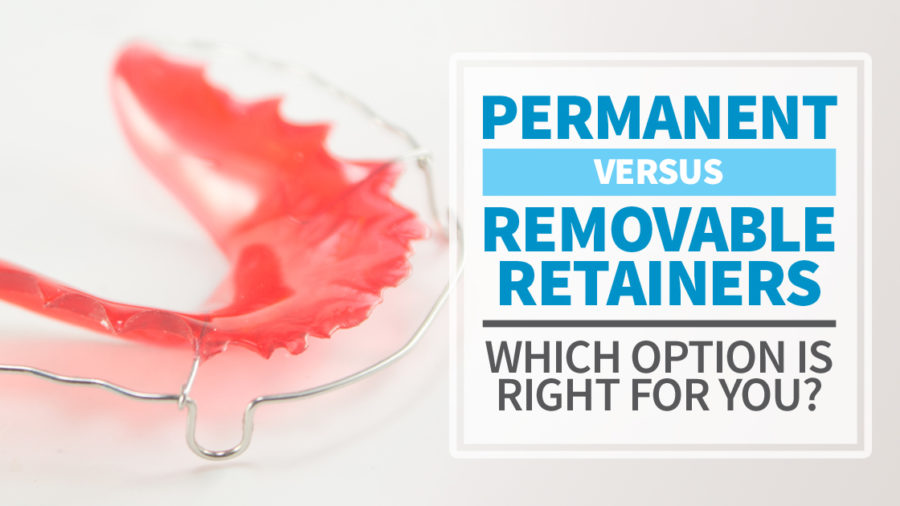When you begin contemplating the decision of permanent vs removable retainers, it’s time for a hearty “congratulations!” After all, this means your time in braces or with your Invisalign treatment are behind you and that you now have the smile you’ve always wanted. However, this doesn’t mean the treatment is over.
Retainers play an essential role in your orthodontic treatment. They hold your teeth in the position that they were moved to with your braces. After all, teeth have the natural tendency to move after orthodontic treatment is complete, especially in the direction where they were initially. This is referred to as relapse. Retainers serve to prevent relapse from taking place so that your time, hard work, and money spent wasn’t wasted.
Chances are, you know someone whose teeth shifted because they didn’t wear their retainer. The majority of patients don’t follow through wearing their retainer, which results in them having to have Invisalign or braces again to fix the relapse that has occurred. This can and should be avoided.
Permanent vs Removable Retainers: Common Questions and Concerns
When discussing permanent vs removable retainers, most patients have a few questions. Some of the common questions we hear include:
- What is the retainer going to look like?
- Will there be a metal bar behind the teeth?
- Is a permanent retainer an option?
- Does the retainer have to be worn all the time?
The fact is, there are two basic types of retainers: removable ones and permanent ones. In some cases, a bonded retainer and removable retainers are used together. However, learning a bit more about each one can help you see the pros and cons they offer. Being informed will help you see why the retainers are such an important part of your orthodontic treatment.
Removable Retainers
These are typically made in the orthodontist’s office by their lab technician. They can be crafted out of clear plastic that is formed by using heat and a model of your teeth. It fits tightly and holds your teeth into their proper position. For the first two months, you will likely be instructed to wear them all day and all night, only taking them out to eat and clean them. After that, patients are typically instructed to wear them each night for the rest of their life. The fact is, retainers are a lifelong commitment. There are many patients who can get up to a decade of use out of a set of retainers prior to having to have them replaced.
The “Pros” of Removable Retainers
 There are a number of advantages to removable retainers, including:
There are a number of advantages to removable retainers, including:
- Clear, virtually invisible and easy to wear
- Can help in protecting dental restorations, such as crowns and fillings, if you clench or grind your teeth
- Covers the teeth and prevents shifting
The “Cons” of Removable Retainers
It is up to you to remember to wear them:
- If the retainers are lost or damaged, you have to pay to have a replacement set made
- If you forget to wear your retainer enough, you could end up getting braces or Invisalign again
Permanent Retainers (Bonded Retainers)
In some cases, a permanent retainer may be the better option. The bonded retainer is made up of a wire that your orthodontist will adhere behind your lower front six teeth to help keep them in their proper position. This is the area where relapse is most likely going to be seen. The bonded retainer is a helpful option if the patient has a large space between the upper front two teeth. After orthodontic treatment is finished and the space is completely closed, the bonded retainer can be used to keep the space closed. Care has to be taken when placing this wire to make sure you don’t bite on the wire or on the adhesive pads holding it in place.
Regardless of if the bonded retainer is on the upper or lower teeth (or both), it is a simple, fast procedure.
The Advantages of Permanent Retainers
Some of the advantages of this type of retainer include:
- Helps to prevent the teeth from shifting
- You don’t have to worry about remembering to wear it
- It is completely invisible to anyone else since it is placed behind the teeth
The Disadvantages of Permanent Retainers
These types of retainers are not used as often as removable retainers because they do represent a few more disadvantages than removable retainers:
- Nothing is really permanent and the retainer can break and have to be replaced
- You have to be careful about what you eat
- You have to be diligent in keeping your retainer clean
- They don’t offer protection against relapse for the back teeth
In some special situations, it will be necessary to use both permanent and removable retainers to ensure relapse doesn’t occur. However, learning more about a permanent vs removable retainer can help you determine what option best suits your needs and lifestyle. It is also a good idea to discuss these options with your orthodontist to see what they recommend.



4 Comments
Leave your reply.